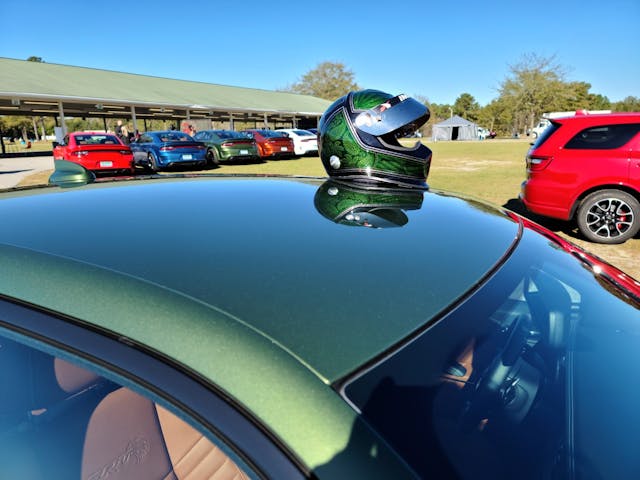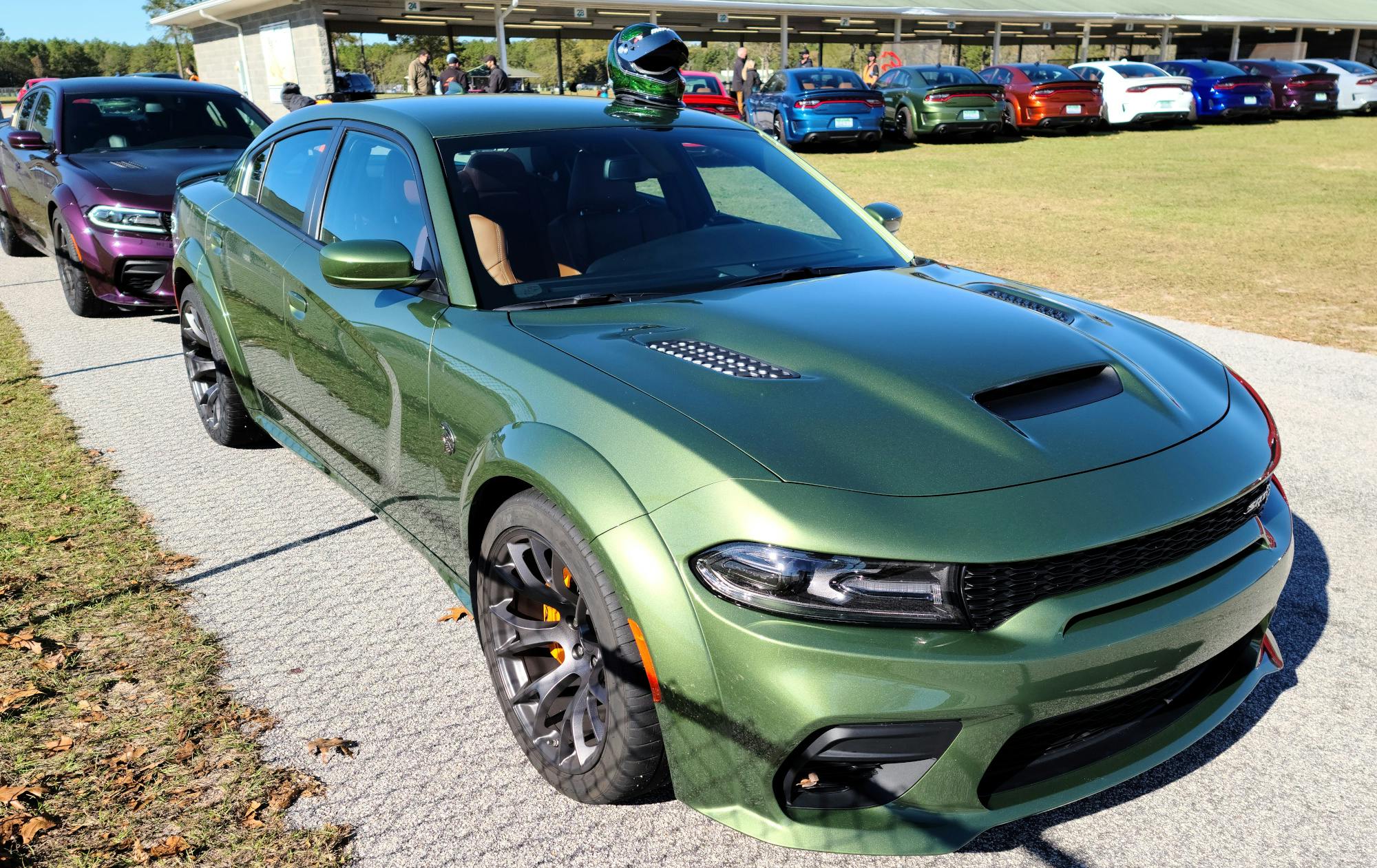Media | Articles
Review: 2021 Dodge Charger Hellcat Redeye Widebody
What great fun it would be to own both this new 797-horsepower Charger and a time machine! Send it back five hundred years and they’d consider it literally demonic, which makes some sense as this big sedan incorporates most engine features of the limited-production Demon drag-strip star. Ninety-five years back and you could set every form of motoring record known to man, from land speed to the upcoming Mille Miglia. The real fun, however, would be to set your time machine for circa 2005, because that’s the era in which you could simply humiliate every single semi-stock car you could possibly encounter at a track day. Corvettes? Naturally. Ferraris? Not even a question. Vipers? Them too.
Six laps at Carolina Motorsports Park was all we needed to know that this $80,000 Dodge can put the serious hurt on victims as diverse as everyday Porsche 911s and all those over-hyped super-SUVs from AMG and BMW M. When it comes to the four-door competition, it’s not just that the Redeye is faster than the $80,000 Germans; it might be faster than all the Germans, period. Along the way, this Charger would collect another, completely unexpected, scalp, namely that of the Challenger Redeye with which it shares a showroom floor. I’ll explain.
Before we get to that, let’s review how a Charger Hellcat becomes a Redeye. Beyond the widebody, there’s a new Hellcat logo on the fenders. It’s chrome with a ruby-tinted eye. Very subtle, at least compared to the massive vinyl versions of the logo soon to appear on rear quarter panels from Charlotte to Los Angeles. Redeyes swap the standard 2.4-liter, 11.6-psi supercharger for a 2.7-liter, 14.5 version. The redline of the Redeye bumps from 6200 rpm to 6500 rpm, although I’m pretty sure my test car called halt on the proceedings via the limiter before 6500 rpm actually came up on the tach. The internal engine modifications from the Demon also make the trip over to Redeye country, along with dual fuel pumps, stronger axles, and an uprated driveshaft. The “Power Chiller” uses the A/C system to lower the temperature of intake air, but it’s designed for drag-strip use more than for multiple-lap track sessions.
That much you can get from the brochure, but what you won’t necessarily hear is that this year’s Charger Redeyes have different front suspension settings to improve turn-in. Somewhat confusingly, the changes actually decrease the rate at which the 305-width front tires pick up grip — but in practice what happens is that the nose bites harder once you’ve completed cranking the steering wheel towards the turn. It’s been an open secret in the Mopar community that Chargers are a little faster around the racetrack than the equivalent Challenger. The longer wheelbase allows the car to be rotated more securely in the midcorner via the throttle. In a car that can’t slide at will, a longer wheelbase is a disadvantage on-track, but the Hellcat’s ferocity turns the tables on that conventional wisdom.
Marketplace
Buy and sell classics with confidence
To that already existing advantage, add the fact that Challenger Widebodys don’t get the improved suspension tuning, and thus the sedan with widebody and Redeye power becomes the fastest version of the platform around a road course. (If you’re curious: The five-speed Benz automatic fitted to the old non-supercharged SRT cars was just a little faster around a race track than the six-speed manual, but the ZF eight-speed used in the current Hellcats turns it from a close thing to an utter rout.)
Two things immediately stand out about the Redeye Widebody on track. The first is that the power difference from the cooking-grade Hellcat is actually a tangible thing; in particular, the car seems much more eager in the small amount of real estate above 5K on the tach. It’s difficult to overstate the ferocity with which the Charger swallows whole sections of race tracks. Like the faster McLarens, this car has the slightly worrying ability to spin its wheels even as it accelerates with rocket-sled force. Unlike the McLarens, it’s best to brake early and often at corner entry. The 400mm steel brakes with six-piston calipers will fade almost immediately on stock pads, particularly the EPA-approved, copper-free pads of the near future. It has to be this way, because any brake pad that could handle this kind of heat (we’re thinking Hawk DTC-70 or above) would be a greased wooden block at everyday temperatures.
The other remarkable aspect of the $80K Charger it the readiness with which it turns into a corner. The square-tire setup (same 305mm width all the way around) makes it a delight to steer, and far more confidence-inspiring through CMP’s kinked third straight than, say, an AMG GT or Porsche 911. It’s always possible to turn the car on the throttle, even in “Street” mode. (“We’re not the fun police” is the verdict from SRT’s legendary engineer Erich Heuschele.) While the most thrilling part of driving most cars on the race track is the so-called midcorner, where the vehicle should be perfectly balanced at maximum grip, the Charger’s best times are had on the way out of the corner, as you use big-toe pressure to determine if you hit your exit mark with ballerina precision or come out sideways in a cloud of white smoke.
Did I say $80K Charger? You’ll really want to make it a $90K Charger; the options include some upscale materials for the interior, a really useful sound system, and various color changes for hood and brake calipers. Quite a bit of money for a rental-car silhouette, but a roaring bargain compared to the Germans. The same monthly payment gets you a Mercedes E53, which offers a positively meek 429 horsepower. Another $30K gets you a comparably equipped E63, which isn’t quite as fast in a straight line and isn’t anything like this good on track.
We’ve all seen this movie before. The fastest daily drivers in history appear just as a Malaise-ish government prepares to clamp down in the name of the environment. So if you didn’t buy a HEMI Cuda in 1971, now’s your chance to buy something much better and faster in 2021. What’s even more fun than putting a Redeye into a time machine? Why, taking it forward in time, behind the wheel.
2021 Dodge Charger Hellcat Redeye Widebody
Price: $80,900 plus options.
Highs: Demon power, road course finesse, tremendously competent in daily use, the best chassis package on an LX-type Chrysler, bargain price for what you get.
Lows: Expensive to buy and run. Doesn’t stand out much after a half-decade of aggressive-looking Chargers with this approximate styling. In a perfect world, there would be a clutch pedal for the purists.
Summary: Surely the best high-power race-track-optimized full-sized sedan in history, for the boutique few who can use it to the extent of its capabilities.
A note: Your humble author was too busy driving the cars to photograph them well — which is okay in this case. You’ve all seen a Charger before, right? — jb














